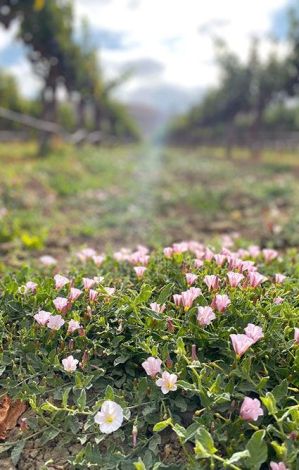Building an Eco-Conscious Vineyard and Winery from the Ground Up
I started the vineyard in 1999 by purchasing undeveloped land on the east side of Paso Robles, CA, after completing a 20 year career at Charles Schwab.
Shortly after planting the vineyard, I decided with my friend Ted to open a winery as partners. Two years and a barn renovation later, Cass Winery opened for business. My son Bryan joined the business shortly thereafter.
From the start, we prioritized creating an environmentally friendly business.
Besides the normal practices of separating trash into a recycle bin, planting drought tolerant ornamentals, and a drip irrigation system, we added a few new twists:
- Every drop of water used to clean barrels and tanks (winery wastewater) is pumped into a reservoir and reused for irrigation.
- The vineyard is certified to be Sustainably Farmed. In order to obtain this certification, there is a lengthy list of practices that need to be followed, including:
- Pests, such as gophers and squirrels are trapped and relocated, not poisoned.
- Hay bales and other controls are installed in erosion prone areas.
- Rows between crops have an over crop to enhance soil health, crowd out invasive weeds, provide a natural nitrogen fix to the soil, and provide habitat for beneficial insects.
- The perimeter of the vineyard also has a cover crop to minimize water runoff.
- Owl boxes are installed to help control gophers and ground squirrels in the vineyard and on adjacent properties.
As a result of these and many other practices, we have not used a pesticide in 19 years, and have never sprayed herbicides.
Climate Change for a Wine Grape Grower
Our vineyard is located in Paso Robles, California. Midway between Los Angeles and San Francisco, about 25 miles from the coast. It’s a semi-arid microclimate, averaging 14 inches of rain per year. That is deceiving because we don’t get 14 inches each year. Rainfall has ranged from five inches to 30 inches in the 20 years we have been here.
We get our water from the largest underground aquifer in the state. Everyone, city and farmers alike get all their water by pumping from wells.
Most of the land that is suitable for farming is zoned agriculture. That is the only permissible use of the land.
The water problem is that agriculture uses a lot of water. No water no agriculture. Wine grapes use 328,000 gallons of water per acre, per year. We have 145 planted acres ourselves and there are thousands of acres grown in the area. The average household uses 30,000 gallons per year.
We recently experienced a five year drought that drained the shallowest of wells, and dropped water levels in the biggest and most robust wells. Many of those older, shallower wells produce smaller amounts and are used for residences. Since this drought, we had two good years of rain, so the water problem moved off the headlines. However, near the end of that five years of drought, there was a lot of debate about the best way to manage our water basin. There was also a lot of hostility between residential users and the ag community.
Here are the highlights of that debate:
- Desalinization Not practical for farming and less so here… not just the cost to desalinate, at $2,000 per acre/ft, but the cost to transport sea water over the coastal range of mountains to inland locations. $2,000 is about the profit margin on an acre of wine grapes, in a good year.
- Buy water from state agencies The advantage of this solution is you can bank water in wet years to use in dry years. However you need a place to store it, which costs money, you need a bigger pipeline to bring it in, which costs money, and there are no guarantees water will be available.
- Recycle Always a good idea, and we do it extensively, however the total quantity of water we get this way does not make much of a difference.
- Reduce water usage Also a good idea, and we have worked hard to reduce our water use by avoiding ornamental lawns, restricting new developments, and encouraging farmers to use less water… in every way they can.
That last bullet point and the last option is a sticky one.
What are the options?
Move to a product that uses less water… means pulling out permanent vines and all the hardware that goes with them. Lose your customer base, rebuild your irrigation system to meet the needs of that new crop. And what crop might that be? Grape vines are already one of the most water efficient crops… row crops such as lettuce use five times the amount of water. Maybe Agave, (for making spirits)… some farms are trying that. However it is a new product for this area, the potential buyers are scarce and the science for growing it here is not widely understood, so there is serious financial risk.
Take tax $$ to fallow your land. If you are growing an annual crop, this might make short term sense… if you have the right to bring it back in the future and payments are guaranteed thru that period. However, with a permanent crop, like an orchard or grape vines you have five years or so for a new planting to provide any crop. I can also see tax payer resistance to paying farmers not to farm.
Use the land for non-ag purposes. We have a housing shortage in our area, but land zoned Ag has severe limitations on housing development. For me it is one house per 40 acre minimum size parcel. I would argue that we should allow land to be re-zoned in favor of less water usage. The land owner could possibly have a greater return without asking the tax payer to foot the bill. Changing the land use ordinances is a major effort, and not easily undertaken, and so far there does not seem to be much appetite for that option. Many would say that argues for urban sprawl and changing the character of the community.
In my view, if you say a property can only be used for Agriculture, you can’t take away water legitimately needed for agriculture. Assuming the need to manage the basin is a serious matter, a change in the zoning is an important tool.


